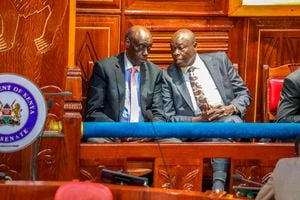Gender equality takes backseat in government plans

Gender mainstreaming helps build a more equitable and inclusive society.
What you need to know:
- The government laid responsibility on employees in the public sector to strive to achieve gender equality in service delivery, staffing, budgeting, programming, and developing policies.
- Performance contracting is a negotiated process that enables State departments to set their performance targets based on their mandates, functions and strategic objectives.
In the financial year 2023/24, the government dropped the gender mainstreaming indicator in performance contracting, thus backtracking 15 years of progress towards attaining equality and equity in the public sector.
Already, the Ministry of Energy and Petroleum is steaming in the back steps.
“For us in the energy sector, we felt a setback in terms of articulating gender issues,” said Dr Faith Wandera-Odongo, director of renewable energy at the Ministry of Energy and Petroleum.
She spoke on May 13, 2024, in Nairobi when Practical Action launched a report containing findings of an assessment of how semi-autonomous government agencies under the Ministry of Energy and Petroleum have integrated gender equality in all policies, plans and programmes.
Inclusion of the gender mainstreaming indicator in performance contracting isn’t a new concept in Kenya.
It was adopted by the government in 2004, following a process of negotiation with key public sector stakeholders, according to the National Gender and Equality Commission, which monitors gender mainstreaming across all ministries, departments and agencies in the national and county governments.
By implementing this strategy through performance contracting, the government laid responsibility on the respective employees in its public sector to strive to achieve gender equality in service delivery, staffing, budgeting, programming, and developing policies.
Performance contracting is a negotiated process that enables State departments to set their performance targets based on their mandates, functions and strategic objectives.
This is according to a 2016 document by the Public Service Commission detailing guidelines for implementation of performance rewards and sanctions in the public service.
These performance targets are subsequently cascaded to the department, directorate, divisions, sections, units and to individual employees.
In making sense of the importance of the gender indicator, Dr Wandera-Odongo correlated the benefits, which include facilitating creation of a roadmap with targets to achieve.
She said, “Setting targets is one way of ensuring that things get done. Without those targets, it’s difficult to track progress and to get budgetary allocations. And without budgetary allocations, you cannot implement anything. So it means you are at the goodwill of other budgets and or you have to depend on the goodwill of other partners to support you.
“So, if you’re not in sync, then your targets will never be achieved as much as you have a work plan. I think it’s something that needs to be looked into because we need to make bigger steps in the energy sector towards gender mainstreaming. There are many, many things that have not been achieved.”
The analysis by Practical Action established that the agencies were at different levels of institutionalising gender mainstreaming with some yet to finalise sexual and gender-based violence policies, while others have little funds allocated to the cause.
Of greatest concern, though, was the finding that the top management had limited understanding of gender mainstreaming, yet they make final decisions on crucial aspects such as budgeting and programming.
“Gender budgeting is still seen as a by the way,” noted Millicent Okello, a gender and inclusion adviser at Practical Action.
“It is, therefore, important to sensitise the top leadership (to gender mainstreaming) if we are to address the issue of budgeting.”
On why the gender mainstreaming indicator was removed, the performance management secretary under the state department of performance and delivery management said on Tuesday in a written response that the indicator was dropped because of non-compliance with the stakeholders’ resolutions on the review of the performance contracting guidelines for the year 2022/23.
“Decisions to add, retain or retire indicators in the Performance Contracting Guidelines emanate from resolutions agreed upon by Ministries, Departments and Agencies (MDAs) during a stakeholders’ forum,” said the secretary in the written response sent through the department under the Ministry of Public Service, Performance and Delivery Management.
“The state department is aware of specific resolutions not adhered to because it was represented and invited to present in the forum.”
The secretary further stated that during the forum the MDAs observed that the indicator had served its purpose and had been entrenched across all MDAs.
They also noted that “the specialised agency has inadequate capacity to oversee implementation of the indicator, and the indicator is anchored in the national values (equality, inclusivity and protection of the marginalised).”





